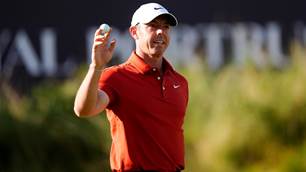As the hours tick down to the last men’s major championship of the year at Royal Liverpool, with Australian Cameron Smith set to defend his title as the ‘Champion Golfer of the Year’, a moment’s pause to consider the impactful deeds of the late Peter Thomson at this venue in 1956 would not be remiss.
At just 26, Thomson outlasted Belgian Flory Van Donck and perennial Open favourite Roberto Di Vincenzo on a 36-hole final day at Hoylake to claim the unique feat of a third-consecutive Open Championship victory.
In truth, he came close to winning five straight before his 30th birthday; after a runner-up finish in 1957 before claiming the Claret Jug again in 1958.
Thomson was 84-years young when I spoke to him prior to the last Open held at Hoylake in 2014 where he was self-effacing about the fact his three-peat performance had not been matched, which remains the case today.
Thomson could always be counted on for a comment on the topical affairs in the game and for a turn of phrase, both in conversation and in his writings on the game, that unfailingly brought a smile to people’s faces. His recollections of the Hoylake links, perched on the coast at the entrance of the River Dee as it spills into the Irish Sea, were no exception.
“The course has been changed since that time, cosmetically,” Thomson said, “I’d call it ‘conveniently flat’ or ‘admirably flat’, but it’s a formidable golf course.
“I don’t know how many bunkers they have there (82 for the 2014 Open) but they all have straight faces, which is the R&A style. If you get caught, you can’t go at the green.”
Unlike Smith’s homecoming with the Claret Jug in tow last summer, Thomson said his three-peat performance in 1956 failed to inspire anything like the same degree of public interest on his return to Melbourne that year. There was the small matter of the ’56 Olympic Games hogging all the attention but in fairness, Thomson said, the golfing world was a lot smaller back then.
 Thomson mused at the fact that in his day, the organising committee to run The Open Championship comprised of one man: Secretary of the Royal and Ancient, Brigadier (Eric) Brickman.
Thomson mused at the fact that in his day, the organising committee to run The Open Championship comprised of one man: Secretary of the Royal and Ancient, Brigadier (Eric) Brickman.
RIGHT: Peter Thomson claims the Claret Jug for the third consecutive year. PHOTO: Getty Images.
The same applied across the pond in America where it was ‘the obligation’ of USGA head Joe Dey to personally stage the national championship. The smaller scale of the event applied equally to the prizemoney pool on offer in the 1950s, comparatively speaking.
“I earned £750 pounds as I recall. They were not the astronomical prizes that they win today. They were pretty miserable by comparison, but I was very happy with it at the time.”
Of course, Thomson was making this comment back in 2014 and the ‘prizes they win today’ have been exponentially elevated at the pointy end of the professional game in the time that has elapsed. And certainly so due to the events of the past year or so.
One wonders what Thomson would make of the current state of men’s professional golf, or that defending champion Smith will arrive at Hoylake having pocketed ‘another’ US$4 million collect from his last start win at the most recent LIV event outside London.
Regardless, Thomson would most certainly be smiling at the prospect of Smith mounting a strong defence and that he will be joined by an additional nine Australians in the field.
It’s a fitting gesture that his son Andrew has sprinkled some of his father’s ashes on the 18th green at each of the courses where Thomson won The Open – including early on Sunday morning before Smith’s epic victory at St. Andrews last year. For the sentimentalists among us, let’s hope it serves as a good omen for more Australian history making at Royal Liverpool this week.
Related Articles

McIlroy's Open inspiration: British Lions, Oppenheimer

Smith recovers from horror start to share Top Aussie honours













